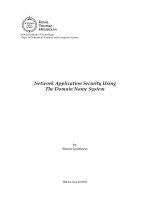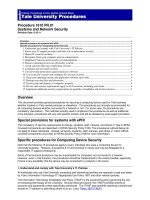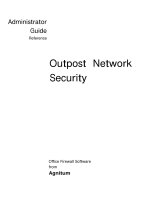Network Perimeter Security potx
Bạn đang xem bản rút gọn của tài liệu. Xem và tải ngay bản đầy đủ của tài liệu tại đây (791.94 KB, 38 trang )
J. Wang. Computer Network Security Theory and Practice. Springer 2008
Chapter 7
Network Perimeter Security
J. Wang. Computer Network Security Theory and Practice. Springer 2008
Chapter 7 Outline
7.1 General Framework
7.2 Packet Filters
7.3 Circuit Gateways
7.4 Application Gateways
7.5 Trusted Systems and Bastion Hosts
7.6 Firewall Configuration
7.7 Network Address Translations
7.8 Setting Up Firewalls
J. Wang. Computer Network Security Theory and Practice. Springer 2008
LANs, WANs, WLANs are known as edge networks
May be contained within businesses or homes
Needs to be protected from the rest of the Internet!
Why firewall?
Encryption?
Cannot stop malicious packets from getting into an edge network
Authentication?
Can determine whether an incoming IP packet comes from a trusted
user
However, not all host computers have resources to run authentication
algorithms
Host computers managed by different users with different skill levels.
Overview
J. Wang. Computer Network Security Theory and Practice. Springer 2008
General Framework
J. Wang. Computer Network Security Theory and Practice. Springer 2008
What is a firewall?
A hardware device, a software
package, or a combination of
both
A barrier between the Internet
and an edge network (internal
network)
A mechanism to filter Incoming
(ingress) and outgoing (egress)
packets.
May be hardware and/or
software
Hardware is faster but can be
difficult to update
Software is slower but easier
to update
General Framework
Firewall placement
J. Wang. Computer Network Security Theory and Practice. Springer 2008
Chapter 7 Outline
7.1 General Framework
7.2 Packet Filters
7.3 Circuit Gateways
7.4 Application Gateways
7.5 Trusted Systems and Bastion Hosts
7.6 Firewall Configuration
7.7 Network Address Translations
7.8 Setting Up Firewalls
J. Wang. Computer Network Security Theory and Practice. Springer 2008
Packet Filters
Perform ingress (incoming) and egress
(outgoing) filtering on packets
Only inspect IP and TCP/UDP headers, not
the payloads
Can perform either stateless or stateful
filtering
Stateless filtering: easy to implement but very simple
Stateful filtering: harder to implement but more powerful
J. Wang. Computer Network Security Theory and Practice. Springer 2008
Stateless Filters
Perform “dumb” filtering
Apply a set of static rules to inspect every packet
Do not keep results from previous packets
A set of rules used is referred to as an
Access Control List (ACL)
Rules are checked from top to bottom and the first rule
found is applied
If no rules match, the packet is blocked by default
J. Wang. Computer Network Security Theory and Practice. Springer 2008
ACL Example
Blocks egress/ingress packets from certain IP address or port
Monitors an ingress packet with an internal address as the source
IP address for possible crafted packet
Identifies Packets that specifies certain router for possible
bypassing firewall
Watches for packets with small payload for possible fragmentation
attack
Blocks control packets from going outside
J. Wang. Computer Network Security Theory and Practice. Springer 2008
Stateful Filters
Smarter than a stateless filter
Keep track of connection states between internal and external hosts
Will only accept/reject based on the connection state
Usually combined with a stateless filter
Must pay attention to memory and CPU time requirements;
connection tracking can be expensive!
Connection state table example
J. Wang. Computer Network Security Theory and Practice. Springer 2008
Chapter 7 Outline
7.1 General Framework
7.2 Packet Filters
7.3 Circuit Gateways
7.4 Application Gateways
7.5 Trusted Systems and Bastion Hosts
7.6 Firewall Configuration
7.7 Network Address Translations
7.8 Setting Up Firewalls
J. Wang. Computer Network Security Theory and Practice. Springer 2008
Circuit Gateways
Operate at the transport layer
Examine information of IP addresses and port numbers in
TCP/UDP headers to determine if a connection is allowed
Usually combined with a packet filter to form a dynamic packet
filter
Basic structure:
Relay a TCP connection between an internal and external host
Disallow direct connection between the external and the internal
networks
Maintain a table for valid connection and check incoming packet
against the table
J. Wang. Computer Network Security Theory and Practice. Springer 2008
Examples
J. Wang. Computer Network Security Theory and Practice. Springer 2008
SOCKetS (SOCKS)
A network protocol for implementing circuit gateway
Consists of three components:
SOCKS server
Run on a packet filtering firewall through port 1080
SOCKS client
Run on an external client host
SOCKS client library
Run on an internal host
Verifies information for authentication and decides
establishing connection upon the information
Provides an authenticated relay for a remote network
J. Wang. Computer Network Security Theory and Practice. Springer 2008
Chapter 7 Outline
7.1 General Framework
7.2 Packet Filters
7.3 Circuit Gateways
7.4 Application Gateways
7.5 Trusted Systems and Bastion Hosts
7.6 Firewall Configuration
7.7 Network Address Translations
7.8 Setting Up Firewalls
J. Wang. Computer Network Security Theory and Practice. Springer 2008
Application Gateways
Also called application-level gateway or proxy server
Act like a proxy for internal hosts, processing service request
from external clients.
Perform deep packet inspection on all packet
Inspect application program formats
Apply rules based on the payload
Have the ability to detect malicious and suspicious packets
Extremely resource intensive
J. Wang. Computer Network Security Theory and Practice. Springer 2008
Cache Gateway
J. Wang. Computer Network Security Theory and Practice. Springer 2008
Application Gateways
Place a router behind the gateway to protect connections between
the gateway and the internal hosts
J. Wang. Computer Network Security Theory and Practice. Springer 2008
Stateful Packet Inspection
Application-level extension of stateful packet
filtering
Support scanning packet payloads
Will drop packets that do not match the expected
connection state or data type for protocol
J. Wang. Computer Network Security Theory and Practice. Springer 2008
Chapter 7 Outline
7.1 General Framework
7.2 Packet Filters
7.3 Circuit Gateways
7.4 Application Gateways
7.5 Trusted Systems and Bastion Hosts
7.6 Firewall Configuration
7.7 Network Address Translations
7.8 Setting Up Firewalls
J. Wang. Computer Network Security Theory and Practice. Springer 2008
Trusted Systems and Bastion
Hosts
Application gateways are placed between the
external and the internal networks
Exposed to attacks from the external network
Need to have strong security protections
Trusted operating system
Bastion hosts
J. Wang. Computer Network Security Theory and Practice. Springer 2008
Trusted Operating Systems
An operating system that meets a particular set of
security requirements
System design contains no defects
System software contains no loopholes
System is configured properly
System management is appropriate
May have users at different levels of security
clearance
Must follow strict rules regarding permissions
J. Wang. Computer Network Security Theory and Practice. Springer 2008
Access Rights
No read-up
Users of a lower level of clearance cannot execute
programs of a higher level of secrecy
Programs of a lower level of secrecy cannot read files of
higher level of secrecy
No write-down
Users of a higher level of clearance cannot use
programs of lower level of secrecy to write data to a file
Programs of a higher level of secrecy cannot write data
into files of a lower level of secrecy
J. Wang. Computer Network Security Theory and Practice. Springer 2008
Bastion Hosts
Systems with strong defensive mechanisms
Serves as hosts computers for implementing:
Gateways
Circuit gateways
Other types of firewall
Operated on a trusted operating system
Must not have any unnecessary functionality!
Keeps the system simple to reduce error
probabilities
J. Wang. Computer Network Security Theory and Practice. Springer 2008
Requirements
Gateway software should be written using only small modules
May provide user authentication at the network level
Should be connected to the smallest possible number of internal
hosts
Extensive logs should be kept of all activity passing through the
system
If they are running on a single host, multiple gateways must
operate independently
Hosts should avoid writing data to their hard disks
Gateways running on bastion hosts should not be given
administration rights









